UI/UX Design
Software Development
+ 2 more ...
Integrating UX Design into Software Development: A Practical Guide for 2025

12 Jun 2025
by Nadiy, Senior Content Writer

12 Jun 2025
by Nadiy, Senior Content Writer
UI/UX Design
Software Development
Mobile App Development
Web App Development
Integrating UX Design into Software Development: A Practical Guide for 2025
Table of contents
Contact us
We will get back to you in the next 48 hours.

In the world of software development, user experience (UX) design is no longer a luxury—it’s a necessity. Learn how integrating UX design into your development process can elevate your product, enhance user satisfaction, and streamline workflows. This guide offers actionable insights to help you succeed in the evolving digital landscape of 2025.
key takeaways
Users expect more than just functional software; they demand seamless, engaging, and intuitive experiences in today’s digital world. Achieving this requires a delicate balance between technology and design, which can only be accomplished when user experience (UX) design is fully integrated into the software development process. But how do you do this effectively?
In this blog, we’ll explore how integrating UX design into software development can unlock new levels of innovation, streamline workflows, and ultimately improve the end-user experience in 2025 and beyond.
The Importance of Integrating UX Design into Software Development
UX design is no longer a "nice-to-have"—it’s a strategic necessity that influences how users perceive, interact with, and ultimately adopt your software. When you integrate UX from the beginning of the development process, you’re not just improving the user interface—you’re laying the groundwork for a more successful, user-centered product.
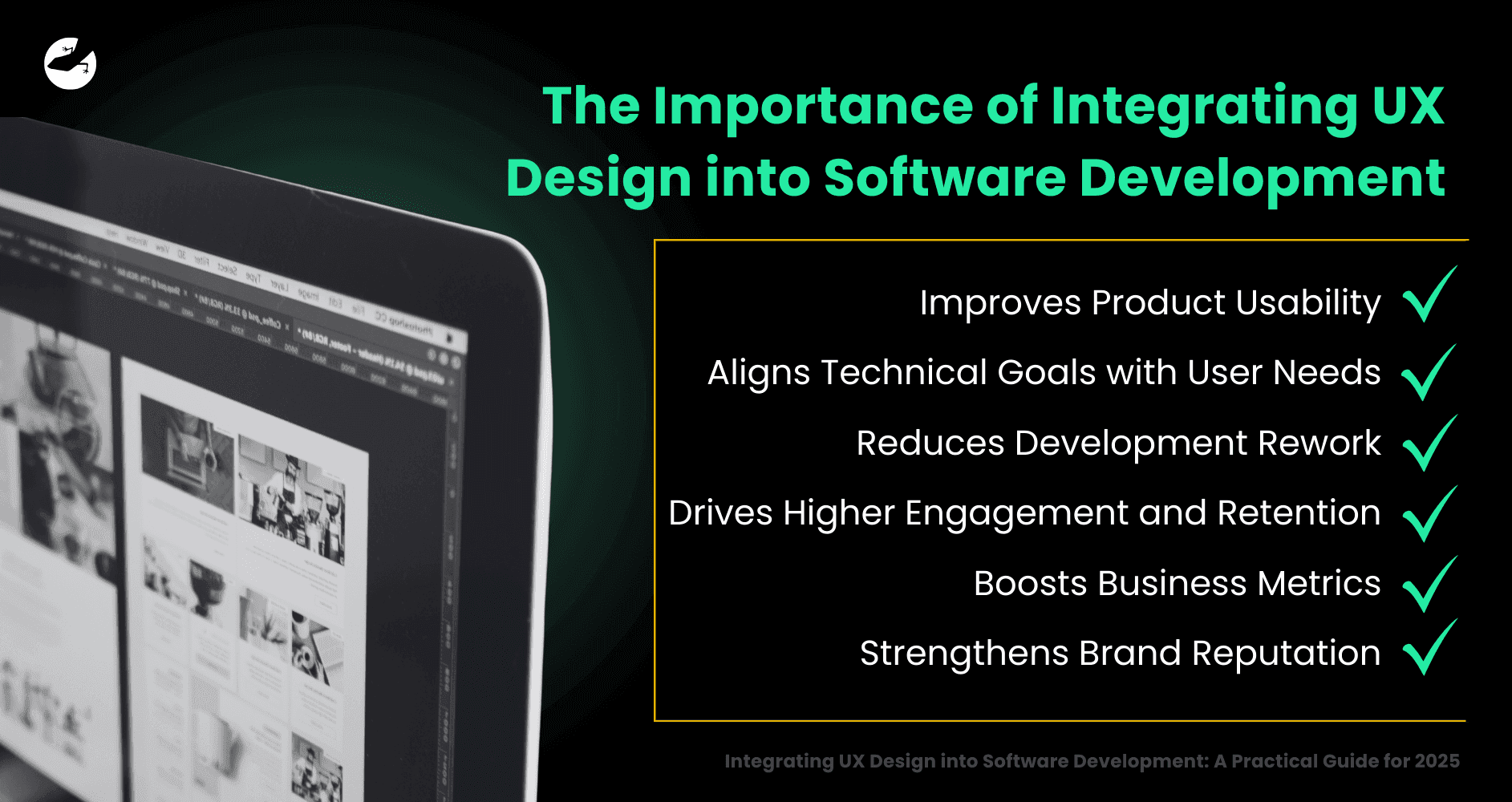
Why it matters:
- Improves Product Usability UX design ensures that every feature and function is easy to understand and intuitive to use, reducing user frustration and onboarding time.
- Aligns Technical Goals with User Needs When UX and development teams collaborate early, developers can build features that are technically sound and tailored to real user behaviors.
- Reduces Development Rework Early wireframes and prototypes help catch usability issues before they become expensive to fix in code.
- Drives Higher Engagement and Retention A seamless user experience keeps users coming back and encourages them to explore more features within the product.
- Boosts Business Metrics Better UX often leads to improved customer satisfaction, higher conversion rates, and lower churn—ultimately driving revenue growth.
- Strengthens Brand Reputation A product that feels effortless to use leaves a lasting positive impression, which helps differentiate your brand in a crowded market.
The Challenges of Integrating UX Design in Software Development
One of the biggest hurdles when combining UX design and software development is the potential for misalignment between design teams and developers. UX designers often focus on aesthetics and the overall experience, while developers are tasked with translating these ideas into a functional product.
Without a cohesive strategy, these two groups might struggle to find common ground, resulting in delays, miscommunication, or subpar results.
To overcome these challenges, it’s crucial to establish a collaborative environment where both developers and designers work closely together from the initial planning phase.
Frequent communication, shared goals, and mutual respect for each other's expertise can make a significant difference in creating a cohesive, high-quality product.
The Step-by-Step Process of Integrating UX Design into Software Development
Successfully merging UX design with software development requires a structured approach. Here’s a step-by-step guide to ensure seamless integration:
1. Early Collaboration Between Designers and Developers
The most effective integration happens when UX designers and developers are involved from day one. Early collaboration ensures that both teams understand the project’s goals and constraints, reducing the chances of design mismatches or technical limitations later on.
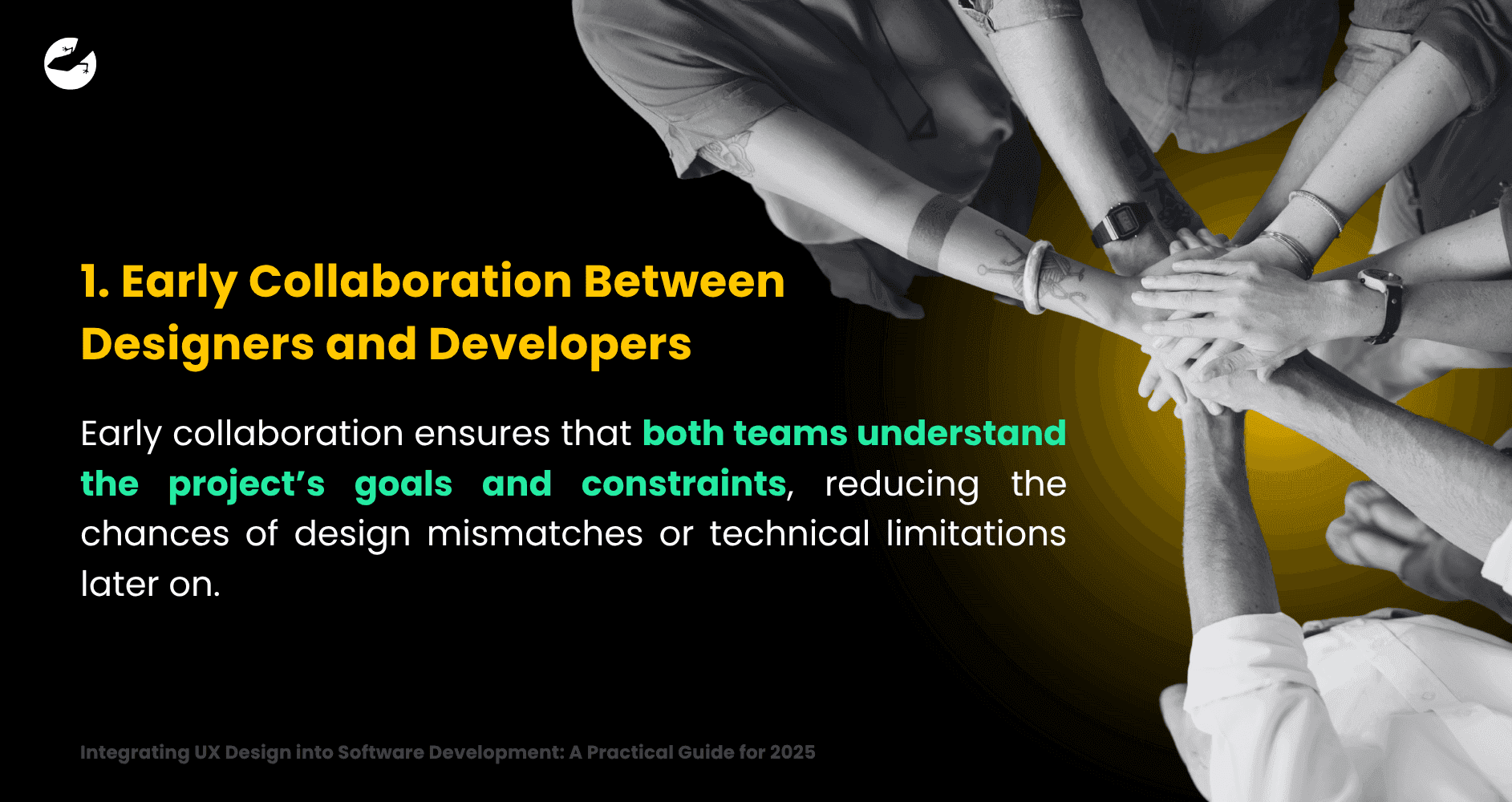
Designers can share their vision for the user experience, while developers can offer input on feasibility, timelines, and technical requirements. By aligning on goals, expectations, and resources, you can set the foundation for a smooth process.
2. Create User-Centered Designs
The core of UX design is understanding the user. Conducting research into user needs, behaviors, and pain points is essential for creating a design that truly resonates with your target audience.
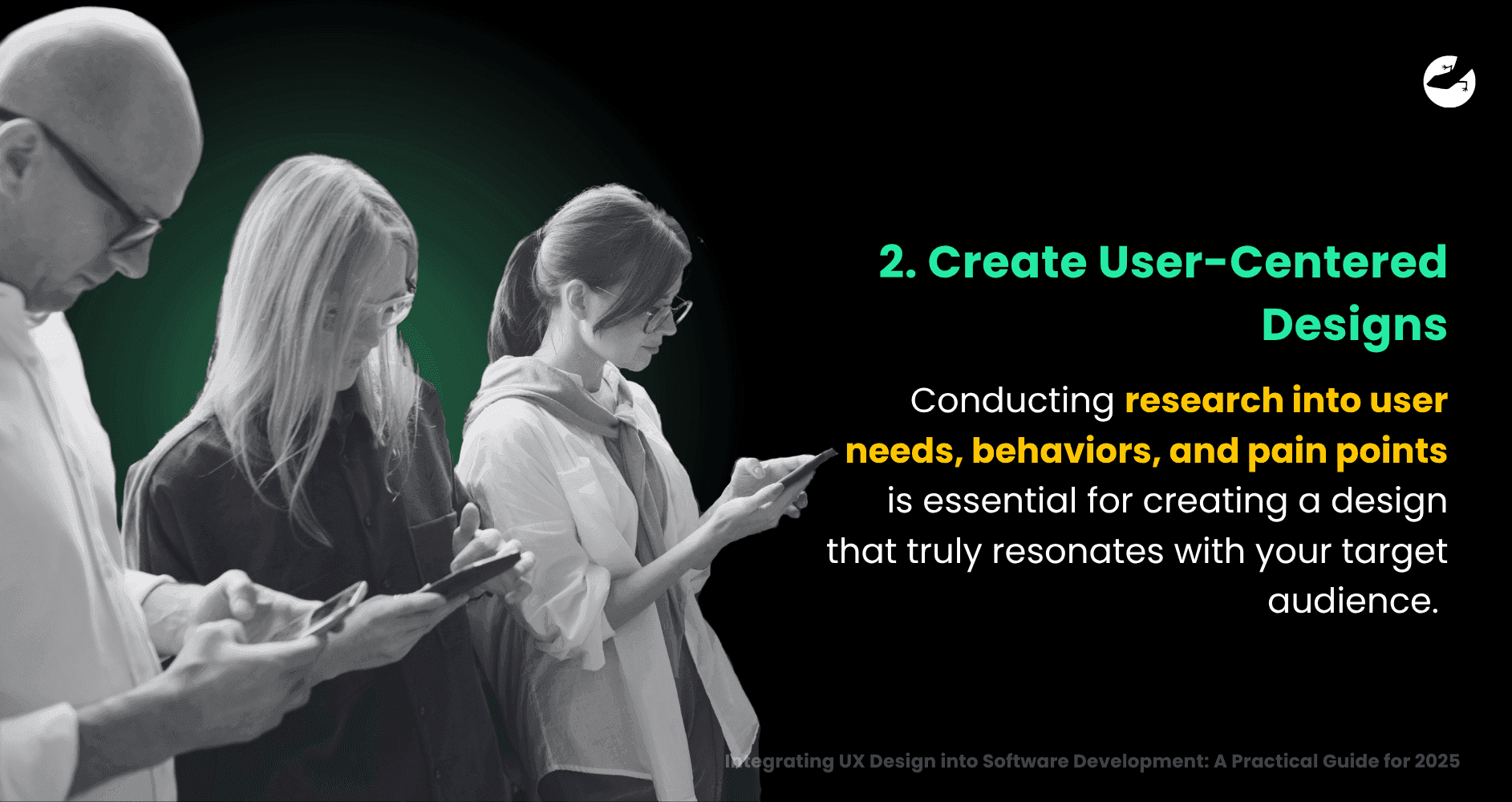
This user-centered approach should inform every aspect of the software development process, from ideation to implementation.
UX designers should develop user personas, journey maps, and wireframes that guide the development process. These artifacts ensure that the software is not just functional but also tailored to the users' expectations, providing an intuitive and engaging experience.
3. Prototyping and Iteration
One of the key advantages of integrating UX design into software development early on is the ability to create prototypes.
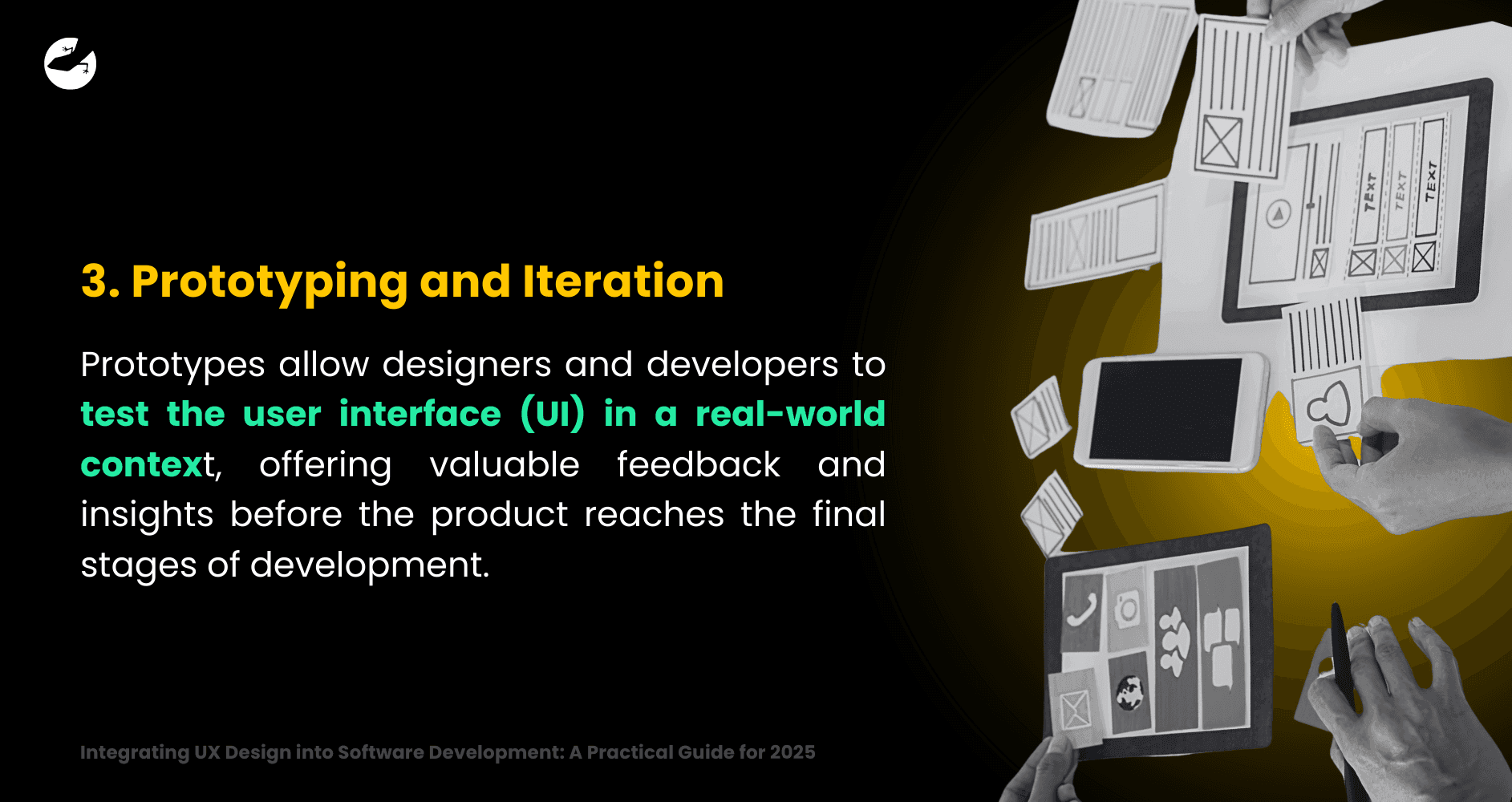
Prototypes allow designers and developers to test the user interface (UI) in a real-world context, offering valuable feedback and insights before the product reaches the final stages of development.
Iterative testing and feedback loops between the design and development teams are crucial during this stage. By continuously refining the product based on real user feedback, both teams can ensure that the software meets both user needs and technical requirements.
Want to find out how much it costs to build your dream app or web app?
4. Adopt Agile Methodology for Continuous Collaboration
Agile development
practices are a perfect fit for integrating UX design into software development. By using agile sprints, development and design teams can collaborate in short, iterative cycles, ensuring constant feedback and adjustment.
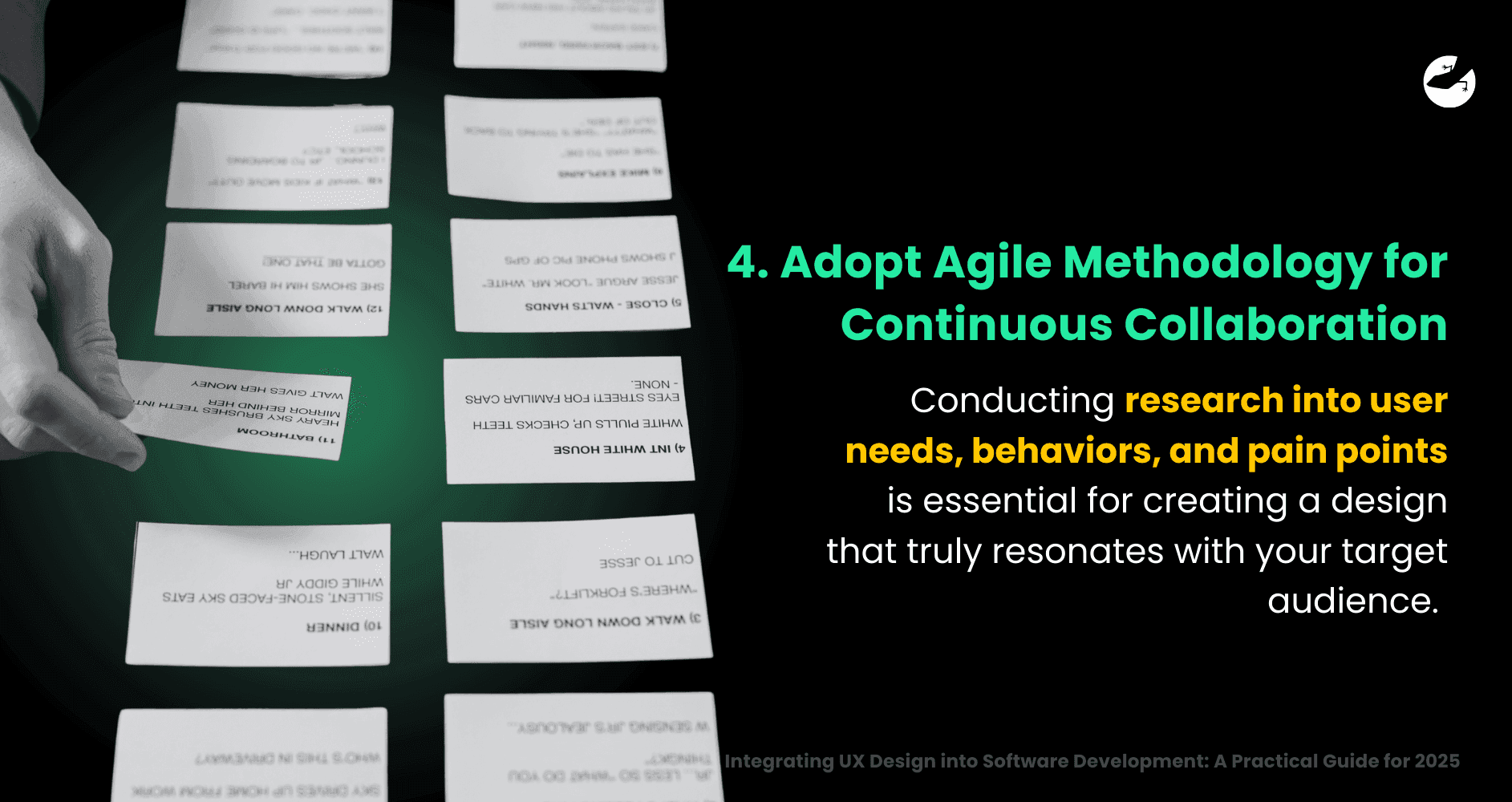
During each sprint, designers and developers should be actively involved in brainstorming, prototyping, testing, and refining.
This iterative process not only accelerates development but also ensures that the product evolves in line with user feedback, reducing the risk of costly redesigns later in the process.
5. Testing and Quality Assurance with a UX Focus
Once the software is in the final stages of development, UX testing becomes a critical phase. This is where user testing, A/B testing, and quality assurance come into play.
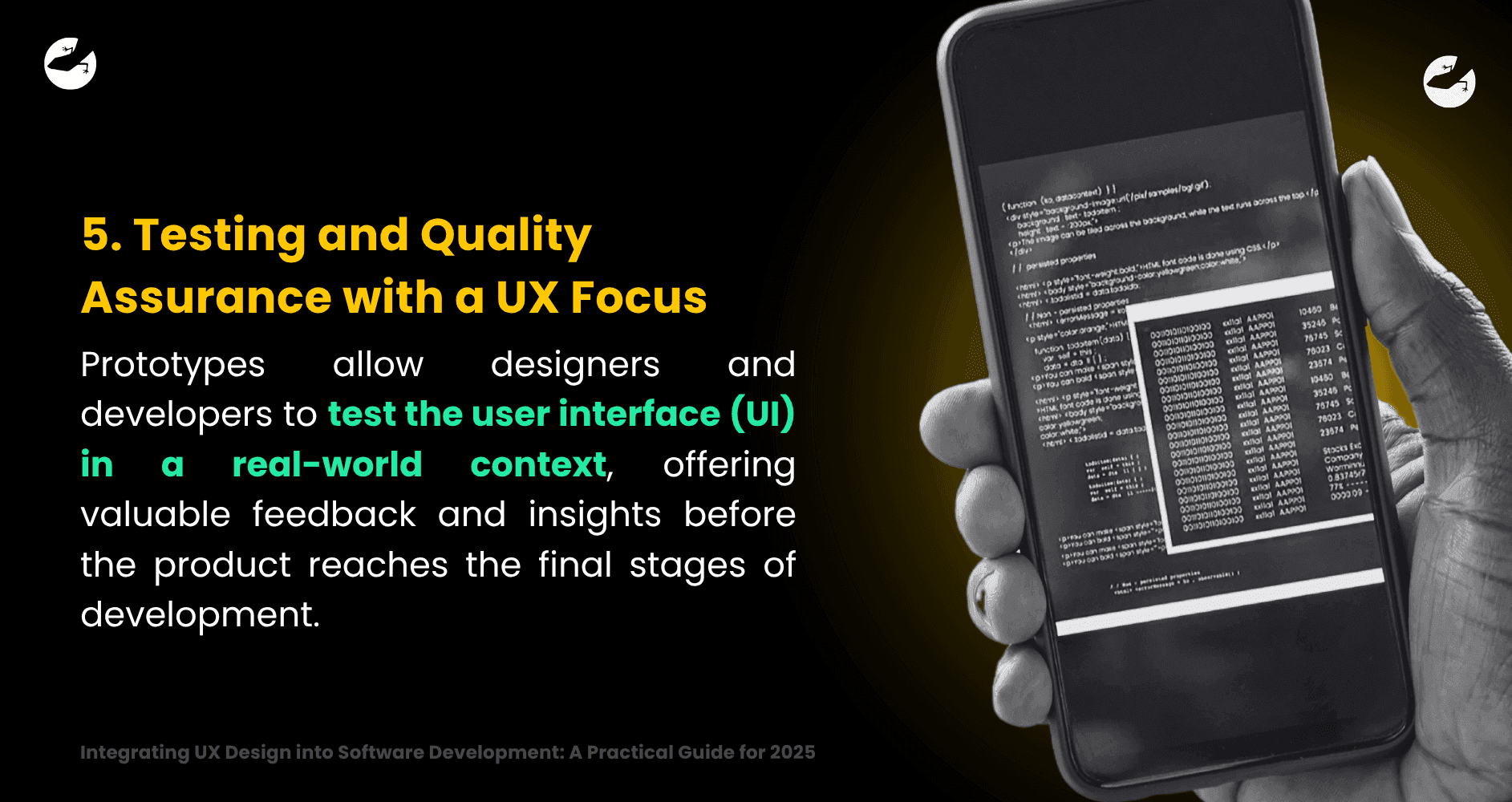
While traditional QA focuses on finding bugs and ensuring functionality, UX-focused testing looks at how users interact with the software and whether their experience aligns with expectations.
In this phase, the development team should prioritize responsiveness, speed, and ease of navigation. UX designers should ensure that the final product delivers an optimal experience across all platforms, devices, and environments.
Tools and Technologies to Aid Integration
Incorporating UX design
into software development is much easier when you leverage the right tools. Some of the most popular tools for collaboration and design integration include:
- Figma and Sketch for collaborative design and wireframing
- Jira and Trello for managing tasks and workflows within agile teams
- InVision for prototyping and real-time feedback
- Zeplin for bridging the gap between design and development

These tools help streamline communication, align design with development, and improve the overall project management process. By using them, teams can track progress, identify potential roadblocks, and ensure everyone is on the same page.
How Lizard Global Can Help You Achieve Seamless UX Integration
At Lizard Global, we understand that the future of software development lies in integrating design and functionality to create outstanding user experiences. As a leading software development company, we work closely with our clients to ensure that every project—whether it’s a SaaS product, mobile app, web app or enterprise solution—delivers a seamless and engaging experience.
combines cutting-edge UX design practices with advanced software development techniques to ensure your product not only functions flawlessly but also delights users.
Whether you’re embarking on a new project or looking to refine an existing product, Lizard Global offers the expertise, tools, and collaborative approach you need to succeed.
By choosing Lizard Global as your development partner, you’re ensuring that your software will meet and exceed user expectations, positioning your brand for success in 2025 and beyond.
Contact us today to learn more about how we can help you integrate UX design into your software development process!
Join 2000+ subscribers
Stay in the loop with everything you need to know

In the world of software development, user experience (UX) design is no longer a luxury—it’s a necessity. Learn how integrating UX design into your development process can elevate your product, enhance user satisfaction, and streamline workflows. This guide offers actionable insights to help you succeed in the evolving digital landscape of 2025.
Users expect more than just functional software; they demand seamless, engaging, and intuitive experiences in today’s digital world. Achieving this requires a delicate balance between technology and design, which can only be accomplished when user experience (UX) design is fully integrated into the software development process. But how do you do this effectively?
In this blog, we’ll explore how integrating UX design into software development can unlock new levels of innovation, streamline workflows, and ultimately improve the end-user experience in 2025 and beyond.
The Importance of Integrating UX Design into Software Development
UX design is no longer a "nice-to-have"—it’s a strategic necessity that influences how users perceive, interact with, and ultimately adopt your software. When you integrate UX from the beginning of the development process, you’re not just improving the user interface—you’re laying the groundwork for a more successful, user-centered product.

Why it matters:
- Improves Product Usability UX design ensures that every feature and function is easy to understand and intuitive to use, reducing user frustration and onboarding time.
- Aligns Technical Goals with User Needs When UX and development teams collaborate early, developers can build features that are technically sound and tailored to real user behaviors.
- Reduces Development Rework Early wireframes and prototypes help catch usability issues before they become expensive to fix in code.
- Drives Higher Engagement and Retention A seamless user experience keeps users coming back and encourages them to explore more features within the product.
- Boosts Business Metrics Better UX often leads to improved customer satisfaction, higher conversion rates, and lower churn—ultimately driving revenue growth.
- Strengthens Brand Reputation A product that feels effortless to use leaves a lasting positive impression, which helps differentiate your brand in a crowded market.
The Challenges of Integrating UX Design in Software Development
One of the biggest hurdles when combining UX design and software development is the potential for misalignment between design teams and developers. UX designers often focus on aesthetics and the overall experience, while developers are tasked with translating these ideas into a functional product.
Without a cohesive strategy, these two groups might struggle to find common ground, resulting in delays, miscommunication, or subpar results.
To overcome these challenges, it’s crucial to establish a collaborative environment where both developers and designers work closely together from the initial planning phase.
Frequent communication, shared goals, and mutual respect for each other's expertise can make a significant difference in creating a cohesive, high-quality product.
The Step-by-Step Process of Integrating UX Design into Software Development
Successfully merging UX design with software development requires a structured approach. Here’s a step-by-step guide to ensure seamless integration:
1. Early Collaboration Between Designers and Developers
The most effective integration happens when UX designers and developers are involved from day one. Early collaboration ensures that both teams understand the project’s goals and constraints, reducing the chances of design mismatches or technical limitations later on.

Designers can share their vision for the user experience, while developers can offer input on feasibility, timelines, and technical requirements. By aligning on goals, expectations, and resources, you can set the foundation for a smooth process.
2. Create User-Centered Designs
The core of UX design is understanding the user. Conducting research into user needs, behaviors, and pain points is essential for creating a design that truly resonates with your target audience.

This user-centered approach should inform every aspect of the software development process, from ideation to implementation.
UX designers should develop user personas, journey maps, and wireframes that guide the development process. These artifacts ensure that the software is not just functional but also tailored to the users' expectations, providing an intuitive and engaging experience.
3. Prototyping and Iteration
One of the key advantages of integrating UX design into software development early on is the ability to create prototypes.

Prototypes allow designers and developers to test the user interface (UI) in a real-world context, offering valuable feedback and insights before the product reaches the final stages of development.
Iterative testing and feedback loops between the design and development teams are crucial during this stage. By continuously refining the product based on real user feedback, both teams can ensure that the software meets both user needs and technical requirements.
Want to find out how much it costs to build your dream app or web app?
4. Adopt Agile Methodology for Continuous Collaboration
Agile development
practices are a perfect fit for integrating UX design into software development. By using agile sprints, development and design teams can collaborate in short, iterative cycles, ensuring constant feedback and adjustment.

During each sprint, designers and developers should be actively involved in brainstorming, prototyping, testing, and refining.
This iterative process not only accelerates development but also ensures that the product evolves in line with user feedback, reducing the risk of costly redesigns later in the process.
5. Testing and Quality Assurance with a UX Focus
Once the software is in the final stages of development, UX testing becomes a critical phase. This is where user testing, A/B testing, and quality assurance come into play.

While traditional QA focuses on finding bugs and ensuring functionality, UX-focused testing looks at how users interact with the software and whether their experience aligns with expectations.
In this phase, the development team should prioritize responsiveness, speed, and ease of navigation. UX designers should ensure that the final product delivers an optimal experience across all platforms, devices, and environments.
Tools and Technologies to Aid Integration
Incorporating UX design
into software development is much easier when you leverage the right tools. Some of the most popular tools for collaboration and design integration include:
- Figma and Sketch for collaborative design and wireframing
- Jira and Trello for managing tasks and workflows within agile teams
- InVision for prototyping and real-time feedback
- Zeplin for bridging the gap between design and development

These tools help streamline communication, align design with development, and improve the overall project management process. By using them, teams can track progress, identify potential roadblocks, and ensure everyone is on the same page.
How Lizard Global Can Help You Achieve Seamless UX Integration
At Lizard Global, we understand that the future of software development lies in integrating design and functionality to create outstanding user experiences. As a leading software development company, we work closely with our clients to ensure that every project—whether it’s a SaaS product, mobile app, web app or enterprise solution—delivers a seamless and engaging experience.
combines cutting-edge UX design practices with advanced software development techniques to ensure your product not only functions flawlessly but also delights users.
Whether you’re embarking on a new project or looking to refine an existing product, Lizard Global offers the expertise, tools, and collaborative approach you need to succeed.
By choosing Lizard Global as your development partner, you’re ensuring that your software will meet and exceed user expectations, positioning your brand for success in 2025 and beyond.
Contact us today to learn more about how we can help you integrate UX design into your software development process!
Join 2000+ subscribers
Stay in the loop with everything you need to know
FAQs

What is Lean Analytics, and how does it work?
How can Lean Analytics help an established business grow?
What are the key metrics for applying Lean Analytics in my business?
How can Lean Analytics improve decision-making in my business?
Is Lean Analytics only for startups or early-stage businesses?
What types of experiments should I run with Lean Analytics?
How does Lean Analytics contribute to operational efficiency?
similar reads







